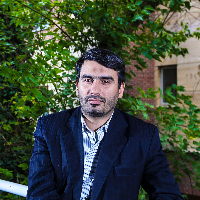Fundamentals of Color Symbolization in Shia and Sunni Theosophy and the Application Patterns in Shia and Sunni Monastery-mausoleums in Iran (Focusing on Monastery-mausoleums of the 8th and 9th Centuries AH in Iran)
Colorful decorations in Islamic architecture have always been the means of expressing meanings. In Islam and Islamic mysticism, color, like other creatures of the universe, is a symbol of something beyond matter. The one and only deity, without forms and material qualities, and of course without color, has manifested himself through the pure light and that light has appeared in multiple colors throughout the universe. In fact, in the case of color interpretation, a kind of cryptography must be used. Decoding the secrets of colors and their interpretations throughout our visual world, including the nature as well as manmade symbols would be possible through the religious knowledge enclosed in the hearts of the sages and mystics. Therefore, it is necessary to refer to the definitions and interpretations of religious leaders, mystics and sages in understanding the mysteries and secrets. The narratives from the Muslim Imams and also the statements of mystics have stressed the importance of color symbolizations within our world. According to the teachings of the Sufis, the esoteric realm of Islamic mysticism has been manifested through secrets and colorful symbols in our art and architecture, particularly within the architecture of monastery-mausoleums (Khaneghah-mazar(, which due to its mystical status was used more than other works of Islamic architecture.The present study aims to provide an interpretation of color symbolizations in Shia and Sunni theosophy and to examine the extent of concordance of those fundamentals between Shia and Sunni monastery-mausoleums of Iran. The research questions are: (1) which colors are important in Shia and Sunni perspectives? (2) Have the color symbolizations in monastery-mausoleums been influenced by the anecdotes and teachings of the theosophists? (3) What are the similarities and differences of color symbolizations in Shia and Sunni monastery-mausoleums? In terms of methodology, this is a descriptive analytic study and a case study research. The data were extracted from the religious and theosophical resources. Then, they were analyzed and compared with other data from field studies. In consideration of the importance of the Sufism during the Ilkhanate and the Timurid periods, various monasteries for a range of Sufi branches such as Nourbakhshieh, Ne’matollahieh, Naghshbandieh were built in those periods and our statistical population is designated as all those monastery-mausoleums built originally in the eighth and the ninth centuries AH. This statistical population includes nine monastery-mausoleums of Chalapi Oghlu in Soltanieh, Sheikh Ala Al-Dawlah Semnani, Sheikh Abdul Samad Isfahani Natanzi, Sheikh Dad in Yazd, Maulana Abu Bakr Zeinuddin Taybadi, Sheikh Ahmad Jami, Bayazid Bastami, Shah Ne’matollah Vali and Sheikh Safi Al-Din Ardabili. Amongst those buildings, four of the most important examples are monastery-mausoleums of Shah Ne’matollah Vali and Sheikh Safi Al-Din Ardabili from the Shia and monastery-mausoleums of Bayazid Bastami and Sheikh Ahmad Jami from the Sunni faith. Those four samples were selected particularly for the present study in which the structures and characteristics of color symbolizations were studied.The results show that according to the Shia ideology, the God is casting a four-sided lighting image over the throne; and those colorful lights, which indicate the light identity of the existence of Imams, are flowing through other material manifestations of the universe. Those colors could be interpreted in slightly different ways at each level of the universe. Those colors are symbols of variations in God’s image through the descending curve, while the potent peripatetic witnesses the colorful images of the creator within the curve of ascendance. Colors are the symbols of steps of the seekers’ demeanor in Sunni theosophy hypotheses as well, and the spectrum of manifested colorful lights indicates the quality of spiritual evolution of the seeker through the ascending path to reach the God. The studies suggest that color decorations in all four monastery-mausoleums are in concordance with those theosophical teachings.In all four instances, the prevalent color used at the external façade is blue, which symbolizes the elementary levels of the spiritual ascendance. The blue color indicates disdaining the horizons within the Sunni teachings while it symbolizes the height of certainty in some symbolization aspects of Shia theosophy. The blue color generally is a symbolization of certainty and the starting point of the path in “Al-baten” (internal/spiritual) characteristics. However, there are differences between Shiite and Sunni monastery-mausoleums within the internal spaces. Red, yellow, gold, green, white and black are more prominent in Shiite monastery-mausoleums that refer to the importance of those colors in Shiite perspective and the roots of guardianship as well as heavenly and extraterrestrial importance of those colors.
- حق عضویت دریافتی صرف حمایت از نشریات عضو و نگهداری، تکمیل و توسعه مگیران میشود.
- پرداخت حق اشتراک و دانلود مقالات اجازه بازنشر آن در سایر رسانههای چاپی و دیجیتال را به کاربر نمیدهد.



